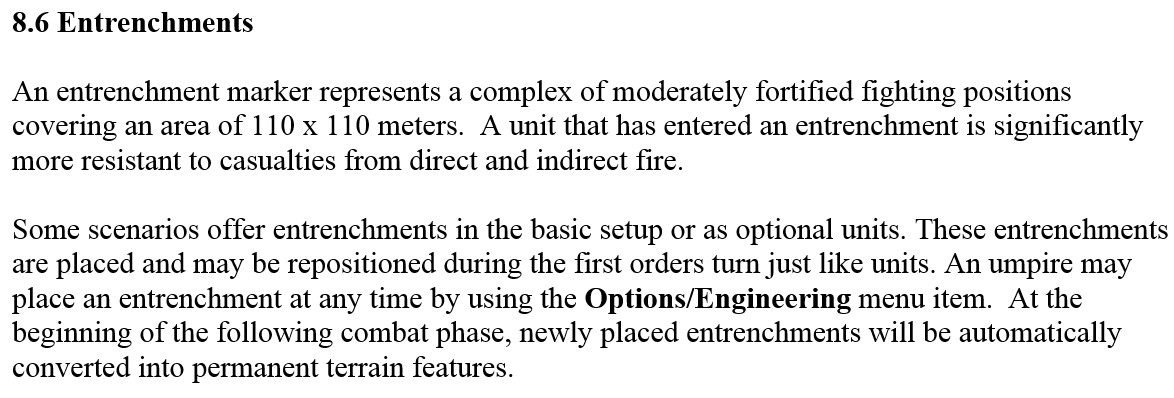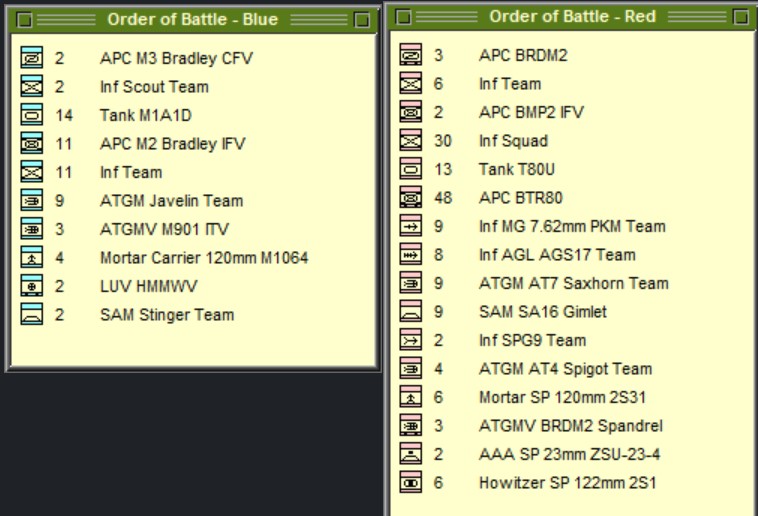"the need for additional engine mechanics, such as trench clearing and their directional properties as structures. Pretty complex with the current code"
Maybe, maybe not. But you're the developer, so it's your call.
Design of models and simulations is very challenging. Some level of abstraction, simplification of reality, is always required. It cannot be avoided. But too many wargames fans have an obsession with perceived "realism" and detail. I think a result of this is that many wargame designers have too often ventured too far down the rabbit hole of "realism" and excessive detail rather than adopting a much simpler but reasonable abstraction that gives reasonable results. Point of Attack from HPS Sims is an example of a game that promised an unprecedented level of realism before its release in early 2003, but its very complex code was buggy and it was impossible to complete a game. It was most likely a total failure commercially, but they had a DoD contract for it as a training aid, so were able to continue developing it.
TacOps, to which I have referred before, included entrenchments.

- TacOps User Guide 8.6 Entrenchments.jpg (128.9 KiB) Viewed 990 times
This screenshot shows how they are made available for Set up:

- TacOps Team Meyers Setup.jpg (189.16 KiB) Viewed 990 times
MISSIONS:
US - Defend Objective A. Keep Objective A clear of enemy forces. There must be no enemy forces in Objective A at the end of 60 minutes. It does not matter if there is no US unit in Objective A at the end of 60 minutes.
OPFOR - Occupy Objective A. There must be at least one OPFOR unit in Objective A at the end of 60 minutes. It does not matter if a US unit is also in Objective A at the end of 60 minutes.
This screenshot shows my typical set up

- TacOps Team Meyers Blue Set Up complete.jpg (170.43 KiB) Viewed 990 times
I always put an entrenchment with a scout team in the lower right corner of the set up area. This position gives a good view of the road from the top right and along the bottom edge.
They get excellent cover, can only be destroyed by direct fire from very close range, and good, but not invulnerable, protection for indirect fire. The entrenchments also appear to treated as camouflaged, unidentifiable as entrenchments until relatively close, unless the occupants open fire, so the scout can continue reporting, unobserved for a considerable time before being discovered.
Similarly, where the road goes through the forested areas in the centre, I place entrenchments on each side of the road on the West edge of the forest. Infantry in these positions ambush vehicles coming through while being supported by tanks and IFV's in the town and forests.
Order of Battle for this scenario:

- Tacops Team Meyers Order of Battle.jpg (84.66 KiB) Viewed 990 times
Bottom line: TacOps inculded a very simple abstraction that did a very good job of entrenchment 31 years ago.
It truly shows its age now, but it solved many of the things asked for by many in AB very simply. On the other hand, AB does many of the things TacOps players asked for.
The perfect game would take the best of TacOps and AB and merge them.
Note, though, that TacOps was designed primarily as a training aid for the USMC and Army, not as a commercial wargame and this undoubtedly ad a huge influence on its development:
TacOps credits:
Credits
Game Design, Development & Coding:
I. L. Holdridge, Major USMC (Retired).
U.S. Army Technical Assistance:
Colonel John Antal, Lt Colonel Scott Glascock, Major James Charlesworth, Major Andre Cota-Robles, Major Daniel Dwyer, Major Mark Holmes, Major Joseph McLamb, Major Michael Muller, Major Eric Wick, Captain James Henry, Mr Eric Andersen, Mr Jeff Perry and others.
Canadian Forces Technical Assistance:
Major James Furnivall, , Major Maurice Audet, Major D. Cote, Major D. Thompson, Major Rod MacKay, Major R.L. Kennedy, Major Francois Lafortune, and others – Canadian Forces
